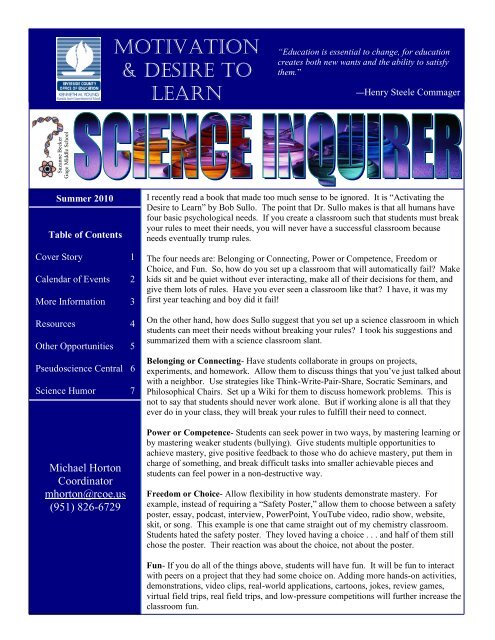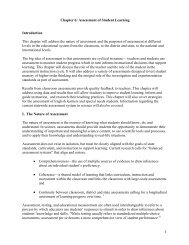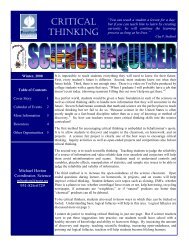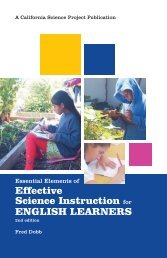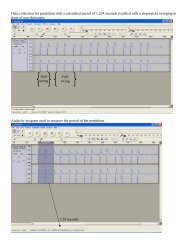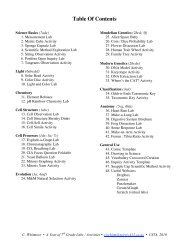Download - scienceinquirer - Wikispaces
Download - scienceinquirer - Wikispaces
Download - scienceinquirer - Wikispaces
Create successful ePaper yourself
Turn your PDF publications into a flip-book with our unique Google optimized e-Paper software.
Suzanne Becker<br />
Gage Middle School<br />
Motivation<br />
& desire to<br />
learn<br />
“Education is essential to change, for education<br />
creates both new wants and the ability to satisfy<br />
them.”<br />
—Henry Steele Commager<br />
Summer 2010<br />
Table of Contents<br />
Cover Story 1<br />
Calendar of Events 2<br />
More Information 3<br />
Resources 4<br />
Other Opportunities 5<br />
Pseudoscience Central 6<br />
Science Humor 7<br />
Michael Horton<br />
Coordinator<br />
mhorton@rcoe.us<br />
(951) 826-6729<br />
I recently read a book that made too much sense to be ignored. It is “Activating the<br />
Desire to Learn” by Bob Sullo. The point that Dr. Sullo makes is that all humans have<br />
four basic psychological needs. If you create a classroom such that students must break<br />
your rules to meet their needs, you will never have a successful classroom because<br />
needs eventually trump rules.<br />
The four needs are: Belonging or Connecting, Power or Competence, Freedom or<br />
Choice, and Fun. So, how do you set up a classroom that will automatically fail? Make<br />
kids sit and be quiet without ever interacting, make all of their decisions for them, and<br />
give them lots of rules. Have you ever seen a classroom like that? I have, it was my<br />
first year teaching and boy did it fail!<br />
On the other hand, how does Sullo suggest that you set up a science classroom in which<br />
students can meet their needs without breaking your rules? I took his suggestions and<br />
summarized them with a science classroom slant.<br />
Belonging or Connecting- Have students collaborate in groups on projects,<br />
experiments, and homework. Allow them to discuss things that you’ve just talked about<br />
with a neighbor. Use strategies like Think-Write-Pair-Share, Socratic Seminars, and<br />
Philosophical Chairs. Set up a Wiki for them to discuss homework problems. This is<br />
not to say that students should never work alone. But if working alone is all that they<br />
ever do in your class, they will break your rules to fulfill their need to connect.<br />
Power or Competence- Students can seek power in two ways, by mastering learning or<br />
by mastering weaker students (bullying). Give students multiple opportunities to<br />
achieve mastery, give positive feedback to those who do achieve mastery, put them in<br />
charge of something, and break difficult tasks into smaller achievable pieces and<br />
students can feel power in a non-destructive way.<br />
Freedom or Choice- Allow flexibility in how students demonstrate mastery. For<br />
example, instead of requiring a “Safety Poster,” allow them to choose between a safety<br />
poster, essay, podcast, interview, PowerPoint, YouTube video, radio show, website,<br />
skit, or song. This example is one that came straight out of my chemistry classroom.<br />
Students hated the safety poster. They loved having a choice . . . and half of them still<br />
chose the poster. Their reaction was about the choice, not about the poster.<br />
Fun- If you do all of the things above, students will have fun. It will be fun to interact<br />
with peers on a project that they had some choice on. Adding more hands-on activities,<br />
demonstrations, video clips, real-world applications, cartoons, jokes, review games,<br />
virtual field trips, real field trips, and low-pressure competitions will further increase the<br />
classroom fun.
Page 2<br />
RCOE Events - http://rcoe.k12oms.org/?gid=426<br />
July 20-22, 2010<br />
Science Notebooks: The Cornerstone of a Powerful Science<br />
Program<br />
September 16, 2010<br />
District Science Leadership Network Meeting<br />
SBCSS Events - http://oms.sbcss.k12.ca.us/index.php<br />
July 21-23, 2010<br />
Service Learning: Through Earth Science<br />
July 28-29, 2010<br />
Service Learning: through Marine Ecology<br />
California Regional Environmental Education Community (CREEC) Events<br />
http://creec.edgateway.net/cs/creec10p/cal/66?x-layout=cal<br />
San Bernardino County Museum Events - http://www.sbcounty.gov/museum/calendar/current.htm<br />
August 21, 2010<br />
August 28, 2010<br />
Moon Party<br />
Family Fun Day - Star Light, Star Bright<br />
September18, 2010<br />
Moon Party<br />
September 18, 2010<br />
Geology Rocks!<br />
Western Center Events - http://www.westerncentermuseum.org/<br />
May 28, 2010 – January 9, 2011<br />
Space Spot – Astronomy Exhibit<br />
Discovery Science Center - http://www.discoverycube.org/events.aspx<br />
May 29 – September 12, 2010<br />
Grossology: The (Impolite) Science of the Human Body<br />
June 5 – September 25, 2010<br />
TINKERTOY: Build Your Imagination<br />
JPL Events - http://www.jpl.nasa.gov/events/<br />
July 22-23, 2010<br />
Moons: The Weirdest Planets In Our Solar System<br />
August 19-20, 2010<br />
Aquarius: Studying Sea Surface Salinity from Space<br />
September 16-17, 2010<br />
Mars Science Laboratory: The Search for Habitable Environments<br />
If you would like to have an event included in a future newsletter, email it 4 weeks prior to the release of<br />
that issue [Summer (June), Fall (October), Winter (January), Spring (April)] to mhorton@rcoe.us.<br />
This calendar of events is not a complete list. Many events are not RCOE events and RCOE cannot verify their content.
More Information<br />
Page 3<br />
Judith Irvin had the same idea, just with different needs and dispositions in “Taking Action in Adolescent Literacy”<br />
quoted below. http://www.ascd.org/publications/books/107034/chapters/Student-Motivation,-Engagement,-and-Achievement.aspx<br />
Adolescents' Needs,<br />
Interests, and Dispositions<br />
Need for control/autonomy<br />
Interest in technology/media<br />
Need to be heard<br />
Disposition to debate<br />
Need to make a difference<br />
Need to belong<br />
Sense of accomplishment<br />
Provide choices in<br />
Assignment topics<br />
Assessment modes<br />
Books to read<br />
Order of completing work<br />
Use technology to support<br />
Communication<br />
Presentation<br />
Research<br />
Possible Instructional Response<br />
Provide authentic audiences, expectations, and opportunities for<br />
writing/speaking for an audience beyond the teacher<br />
Plan many opportunities for<br />
Debate<br />
Text-based discussion<br />
Opinion boards<br />
Blogs<br />
Letters to the editor<br />
Student correction of content/format errors<br />
Set up opportunities for<br />
Reading to/tutoring others<br />
Research into real issues<br />
Apprenticeships/Internships<br />
Creating informational Web sites<br />
Writing articles for publication<br />
Peer editing<br />
Create a classroom culture and reinforce classroom norms that support the<br />
development of a community of readers, writers, and thinkers<br />
Teach students how to participate in<br />
Goal setting<br />
Progress monitoring<br />
Use of rubrics<br />
Collaborative teaming for completion of tasks
Resources<br />
Page 4<br />
Online Resources:<br />
Sample chapters from Bob Sullo’s “Activating the Desire to Learn” can be downloaded here:<br />
http://www.ascd.org/publications/books/107009.aspx.<br />
“The Six C’s of Motivation” can be read here:<br />
http://projects.coe.uga.edu/epltt/index.php?title=Six_C%27s_of_motivation. The Six C’s of Motivation<br />
are: choice, challenge, control, collaboration, constructing meaning, and consequences. Visit the site to<br />
see what each one means, for example, “consequences” does not mean “punishment.” It means<br />
publishing, displaying, presenting, or uploading the student work so that others may see it.<br />
PowerPoint: “What Does the Research Say? Motivation and Achievement in Secondary Schools”<br />
http://anneerickson.efoliomn1.com/vertical/Sites/%7B83554CFC-CA28-468E-B516-<br />
6B7B2D082F96%7D/uploads/%7B8A6885A8-C8BA-408F-A7FF-130CC227DCB3%7D.PPT<br />
How Can Teachers Develop Students’ Motivation - - And Success?<br />
http://www.educationworld.com/a_issues/chat/chat010.shtml<br />
Books:<br />
“Activating the Desire to Learn” can be downloaded here:<br />
http://shop.ascd.org/productdisplay.cfm?productid=107009.<br />
“Visible Learning: A Synthesis of Over 800 Meta-Analyses Relating to Achievement”<br />
http://www.amazon.com/Visible-Learning-Synthesis-Meta-Analyses-<br />
Achievement/dp/0415476186/ref=sr_1_1?ie=UTF8&s=books&qid=1276898454&sr=8-1<br />
“What Every Teacher Should Know About Student Motivation”<br />
http://www.amazon.com/Every-Teacher-Should-Student-<br />
Motivation/dp/1412971764/ref=sr_1_1?ie=UTF8&s=books&qid=1276898611&sr=1-1
Page 5<br />
High-Speed Videos<br />
I have a new high speed video camera that can record 600 frames per second in color! I uploaded a few<br />
sample videos (tuning fork, balloon popping, and stopwatch). I would like to make videos for teachers to<br />
use in classrooms. If you have suggestions for videos, email them to me at mhorton@rcoe.us. If you have<br />
items to send to be used in the video, just send them to RCOE through the district mail to RCOE, Division<br />
of Educational Services, District and School Success Center, Attn: Mike Horton, Coordinator.<br />
I have some videos on the website at http://<strong>scienceinquirer</strong>.wikispaces.com/movies. I can put rulers<br />
and/or grids in the background for quantitative analyses of the videos. At 250 frames per second, the<br />
camera can capture water balloons bouncing, low frequency vibrations, toys, rocket launches, etc.<br />
Toy Ball Bouncing<br />
Gauss Rifle Firing<br />
Website Update<br />
Crane Fly at 100X<br />
What is this??<br />
http://<strong>scienceinquirer</strong>.wikispaces.com/Microscope<br />
The higher the magnification of a microscope, the smaller its “Depth of Field.” This means that only a small part of the picture<br />
is in focus at a time. Recently, my daughter and I have been experimenting with “Focus Stacking” of microscope photos and<br />
you can see them on the website (and some examples above). Focus stacking involves taking hundreds of pictures of the same<br />
object focused at different depths and then using a computer program to combine all of the focused parts of the pictures<br />
together into one focused picture. See the example of an ant below (only 3 photos shown).
Page 6<br />
Subliminal Advertising<br />
You’ve all heard the story about the scientist who inserted subliminal messages into a movie for a soft drink and sales<br />
skyrocketed 57.8%. The “scientist” was James Vicary, the movie was “Picnic” . . . and none of this ever happened.<br />
Vicary admitted to lying in 1962. The theater where it was supposedly performed doesn’t even have enough seats to<br />
have been the theater in the experiment.<br />
Dr. Henry Link repeated the experiment and found no growth in sales. Vicary did an experiment on TV flashing “call<br />
now” on a call-in program and calls did not increase. Similar experiments found results equal to or not much better than<br />
placebo effect or pareidolia. Pareidolia is the brain’s attempt to find patterns in randomness. It explains common<br />
phenomena like faces in grilled cheese sandwiches, ghostly voices in “Electronic Voice Projections,” clouds shaped like<br />
animals, the face on Mars, Rorschach inkblot tests, and hidden messages when music is played backwards.<br />
Most purported subliminal advertising in print ads are pareidolia and some were clearly placed to be noticed and<br />
therefore are not subliminal at all. Many are just people looking for the word “sex” in smoke, mirrors, lights, hair, and<br />
liquids and zooming in too far.<br />
Here is one claimed to be an ice cube with hidden messages in it. The “evidence” is: 1) Ice cubes don’t have holes in<br />
them (red arrow) 2) There are images such as a monstrous head (red oval), a snake’s head (green arrow), and fish<br />
(black arrows). First, it’s not an ice cube, it is swirling liquid and second, it’s a clear case of pareidolia.<br />
The best point came from a 1994 study concluding that advertisements that you can actually see (supraliminal) work far<br />
better than those that you cannot see. A soda commercial at the beginning of a movie works far better than flashing<br />
subliminal soda messages throughout the movie.
Page 7<br />
Science Humor<br />
(or at least what passes for humor here)<br />
Biological Science: A contradiction in terms.<br />
Science Definitions:<br />
From: http://www.ahajokes.com/sci65.html<br />
Bunsen Burner: A device invented by Robert Bunsen (1811-1899) for brewing coffee in the laboratory,<br />
thereby enabling the chemist to be poisoned without having to go all the way to the cafeteria.<br />
Clinical Testing: The use of humans as guinea pigs.<br />
Inorganic Chemistry: That which is left over after the organic, analytical, and physical chemists get through<br />
picking over the periodic table.<br />
Physical Chemistry: The pitiful attempt to apply y=mx+b to everything in the universe.<br />
Scientific Method: The widely held philosophy that a theory can never be proved, only disproved, and that<br />
all attempts to explain anything are therefore futile.<br />
Spectrophotometry: A long word used mainly to intimidate young students.


